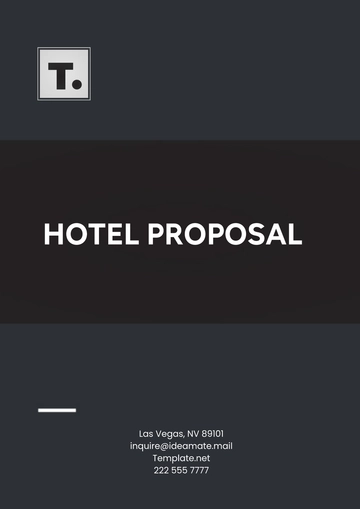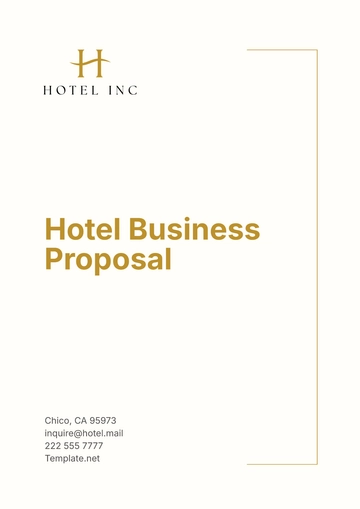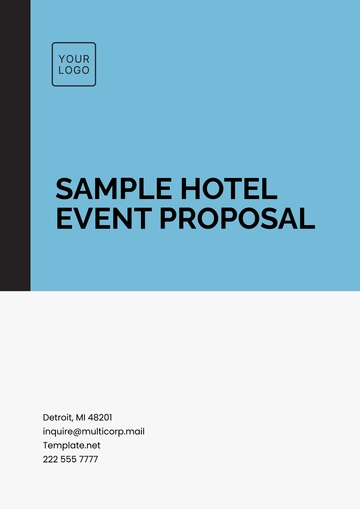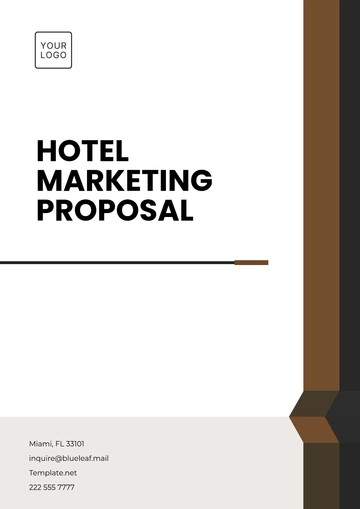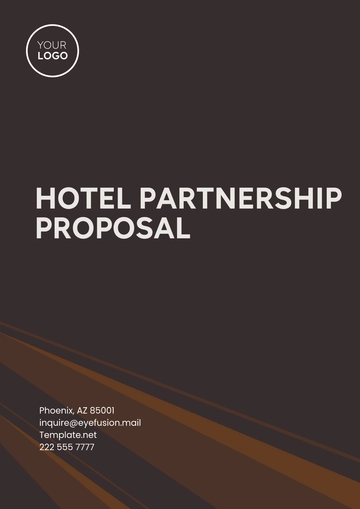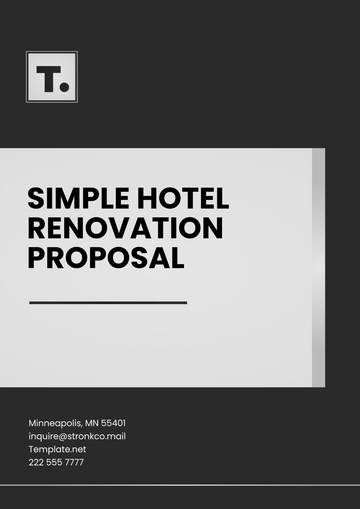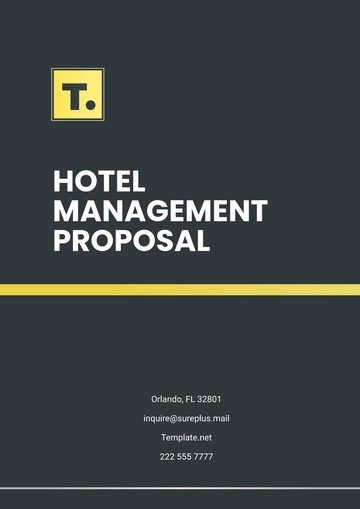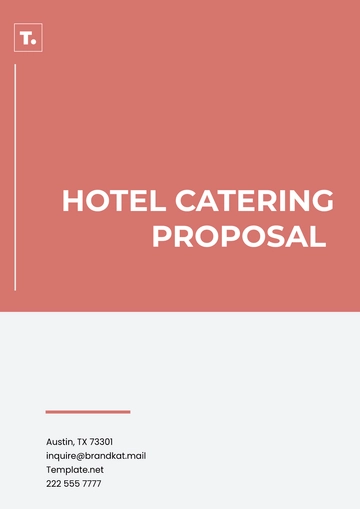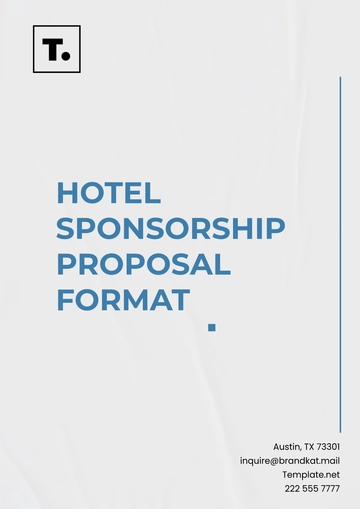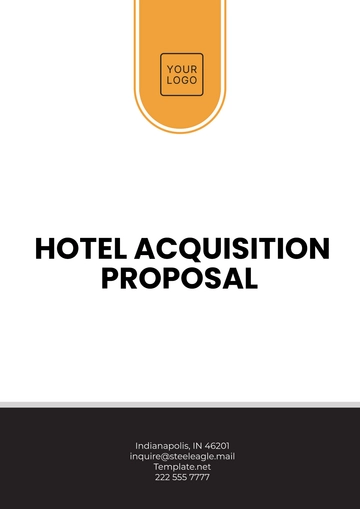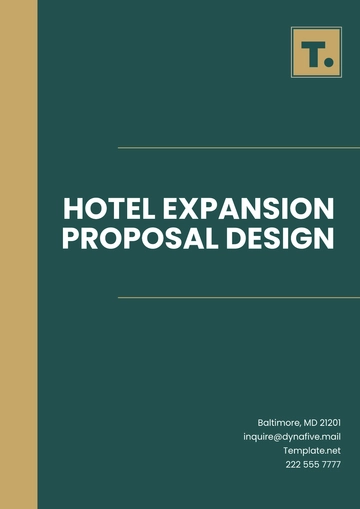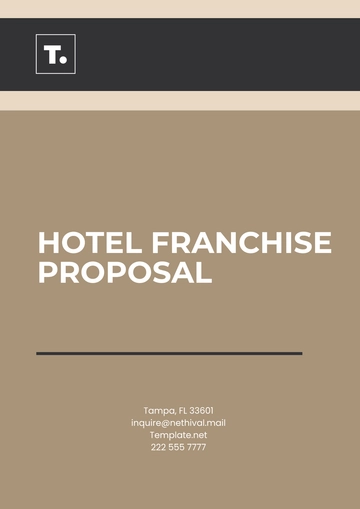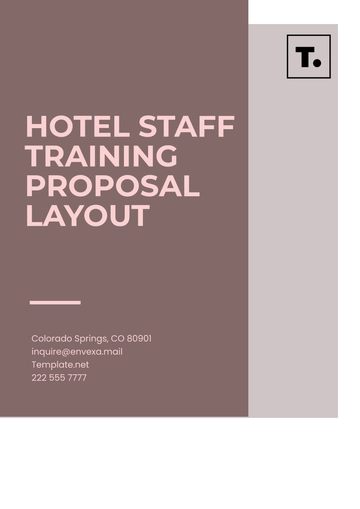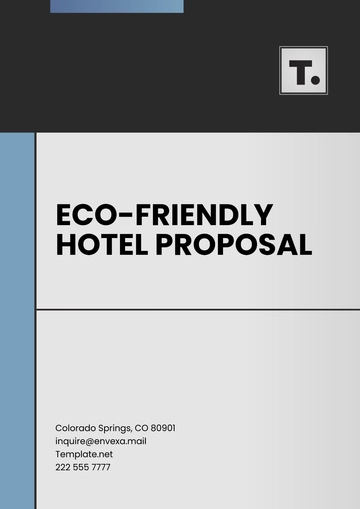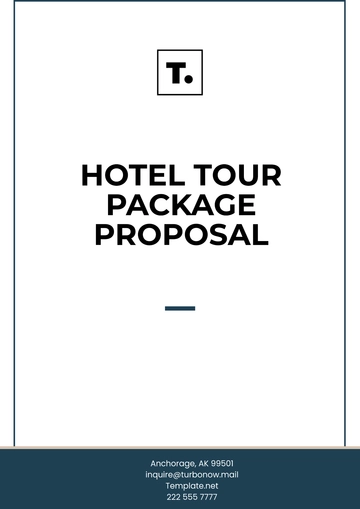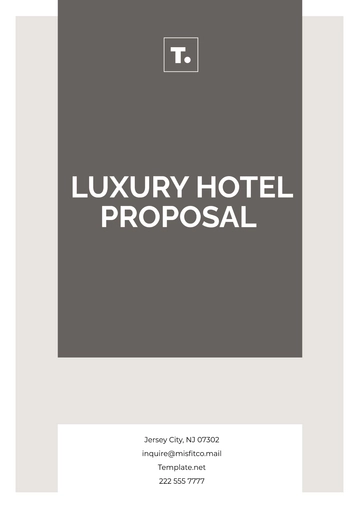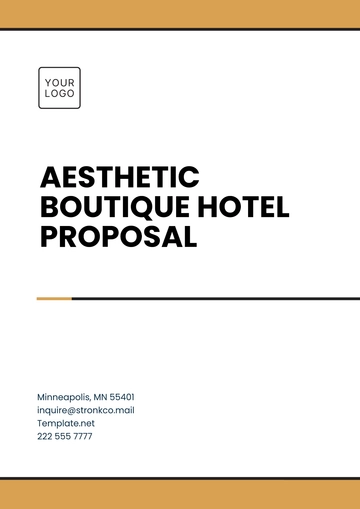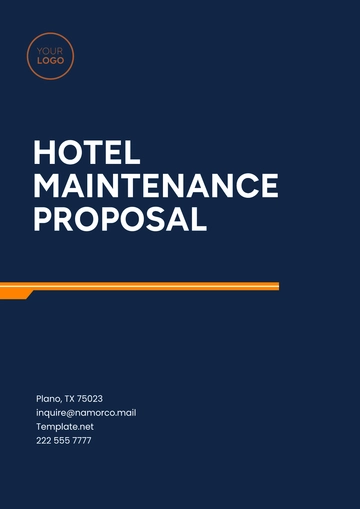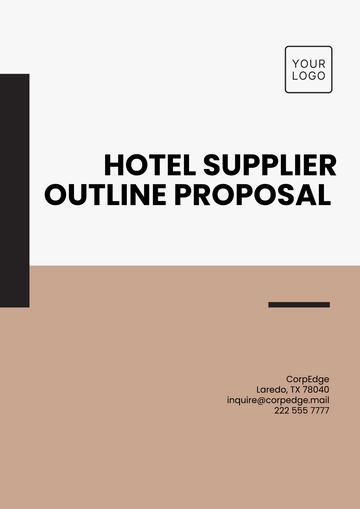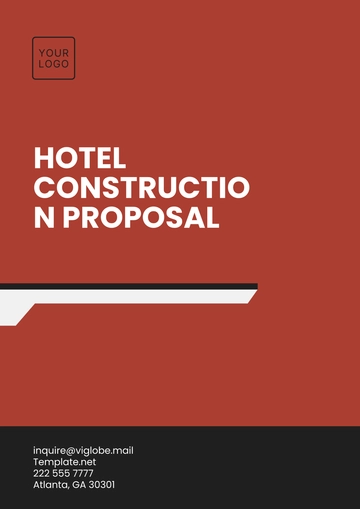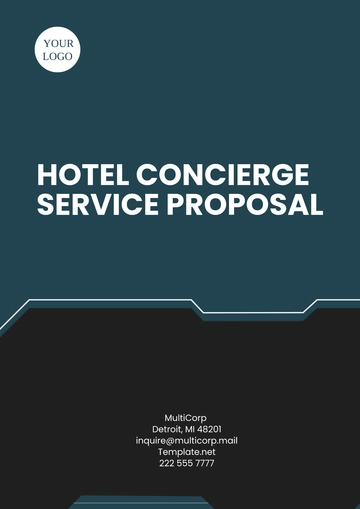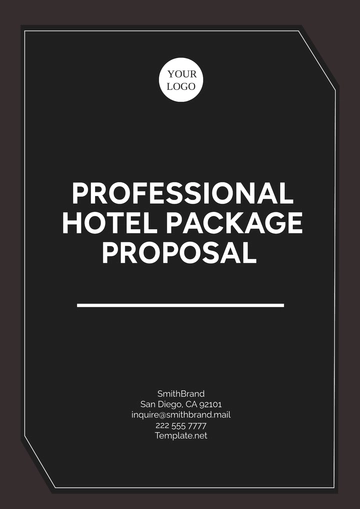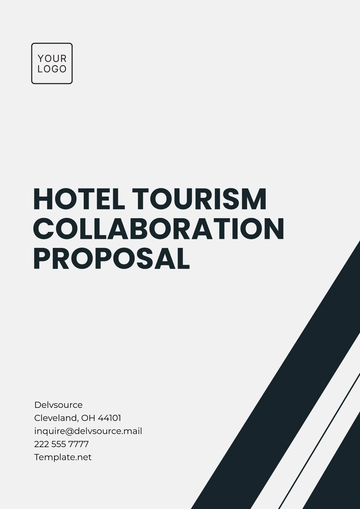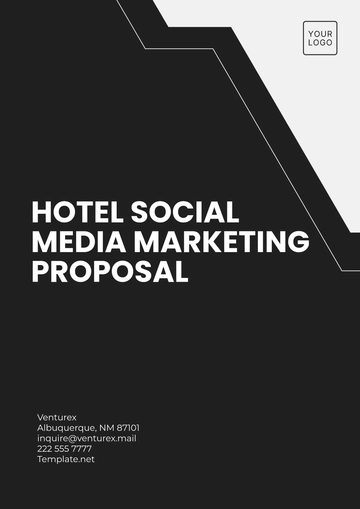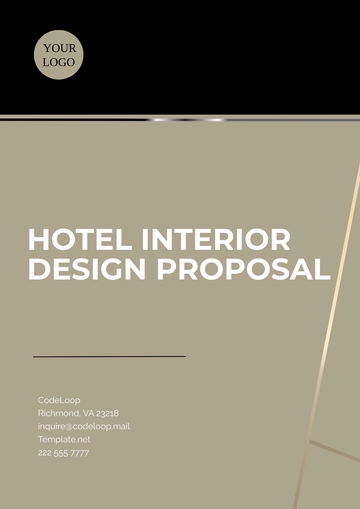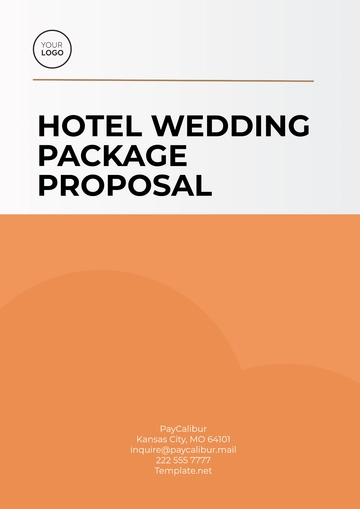Free Hotel Project Proposal
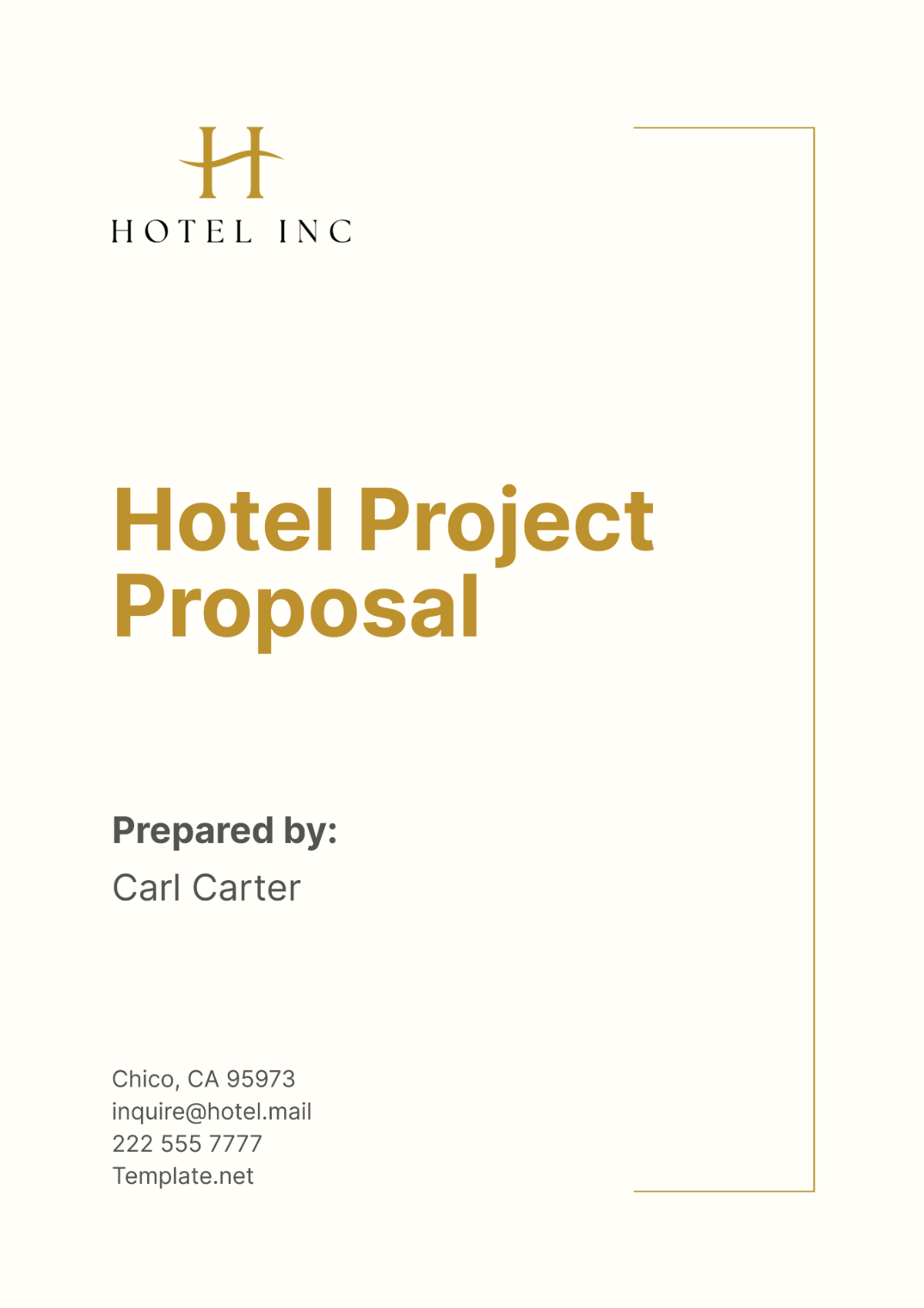
I. Executive Summary
In 2054, [Your Company Name] aims to launch an innovative project to enhance guest experiences and increase revenue streams. The proposed project involves the development of a state-of-the-art wellness center, integrating cutting-edge technology and sustainable practices. The total budget for this project is $5,000,000, and the estimated timeline for completion is 18 months. This proposal outlines the project objectives, scope, financial analysis, and implementation plan.
The wellness center will feature advanced spa facilities, fitness studios, and wellness programs tailored to meet the diverse needs of our guests. By leveraging the latest technology, we aim to offer personalized wellness experiences, thereby attracting health-conscious travelers and increasing our competitive edge. The project aligns with our strategic goals of promoting sustainability, enhancing guest satisfaction, and driving long-term profitability.
The proposal includes a detailed financial analysis, highlighting the projected revenue increase and cost savings. A comprehensive implementation plan with clearly defined milestones ensures that the project stays on track and within budget. This wellness center is not only an investment in our facilities but also in our brand reputation and market positioning.
II. Project Objectives
A. Enhance Guest Experience
To provide a comprehensive wellness experience. The new wellness center will offer a variety of services, including spa treatments, fitness classes, and personalized wellness programs. These services are designed to cater to the health and well-being needs of our guests.
To integrate advanced technology for personalized services. Implementing AI-driven fitness assessments and virtual wellness consultations will allow guests to receive tailored recommendations. This personalized approach can significantly enhance guest satisfaction.
To create a tranquil and rejuvenating environment. The wellness center will feature serene design elements and sustainable materials, creating a peaceful atmosphere. This environment will help guests relax and rejuvenate during their stay.
To offer exclusive wellness packages. Developing unique wellness packages that include accommodations, spa treatments, and fitness activities can attract health-conscious travelers. These packages can also increase average spending per guest.
To promote long-term guest loyalty. By providing exceptional wellness experiences, we aim to build strong relationships with our guests. Satisfied guests are more likely to return and recommend our hotel to others.
B. Increase Revenue Streams
To attract a new market segment of wellness travelers. The wellness industry is rapidly growing, and this project positions us to tap into this lucrative market. By attracting wellness travelers, we can increase occupancy rates and revenue.
To boost ancillary revenue through spa and fitness services. The wellness center will offer a range of paid services, including spa treatments and fitness classes. These services are expected to generate significant ancillary revenue.
To offer corporate wellness programs. Partnering with businesses to provide corporate wellness retreats and programs can open new revenue channels. These programs can be marketed to companies looking to invest in employee well-being.
To increase the Average Daily Rate (ADR). Enhancing our wellness offerings allows us to justify higher room rates. Guests are willing to pay a premium for access to high-quality wellness facilities.
III. Project Scope
A. Facility Development
Construction of a state-of-the-art wellness center. The center will include spa facilities, fitness studios, and relaxation areas. The design will focus on creating a calming and luxurious environment for guests.
Incorporation of advanced wellness technology. The wellness center will feature the latest technology, such as AI-driven fitness assessments and virtual wellness consultations. These innovations will provide personalized experiences for guests.
Use of sustainable and eco-friendly materials. The construction will prioritize sustainability by using eco-friendly materials and energy-efficient systems. This approach aligns with our commitment to environmental responsibility.
Design of serene and aesthetically pleasing interiors. The interiors will be designed to promote relaxation and well-being, with soothing colors and natural elements. Creating a visually appealing space enhances the overall guest experience.
Integration of wellness programs and services. The wellness center will offer a variety of programs, including yoga classes, meditation sessions, and nutrition workshops. These programs are designed to cater to the diverse needs of our guests.
B. Financial Analysis
The following table presents the estimated costs and projected revenue for the wellness center project:
Cost/Revenue Item | Amount |
|---|---|
Construction Costs | $3,000,000 |
Technology Integration | $500,000 |
Sustainable Materials | $300,000 |
Interior Design | $700,000 |
Marketing and Promotion | $500,000 |
Projected Annual Revenue | $2,500,000 |
The data above outlines the major cost components and the expected revenue from the wellness center. This financial analysis helps in understanding the investment required and the potential return on investment.
Construction Costs: Allocating $3,000,000 for construction ensures that we develop a state-of-the-art facility. This significant investment is necessary to build a wellness center that meets our high standards and attracts discerning guests.
Technology Integration: With $500,000 allocated for technology, we can incorporate advanced systems that enhance the guest experience. AI-driven assessments and virtual consultations are key features that differentiate our wellness center from competitors.
Sustainable Materials: Investing $300,000 in eco-friendly materials supports our commitment to sustainability. This not only appeals to environmentally conscious guests but also reduces long-term operational costs.
Interior Design: The $700,000 budget for interior design ensures that we create a visually appealing and relaxing environment. A well-designed space is crucial for delivering a premium wellness experience.
Marketing and Promotion: A $500,000 marketing budget is allocated to promote the wellness center and attract guests. Effective marketing strategies are essential for maximizing the reach and impact of our new facility.
The projected annual revenue of $2,500,000 indicates a strong return on investment. By attracting wellness travelers and offering premium services, we can achieve significant revenue growth. This financial analysis highlights the importance of strategic investments in facilities, technology, and marketing to drive long-term profitability.
IV. Implementation Plan
A. Project Timeline
The following table outlines the estimated timeline for the wellness center project:
Phase | Duration |
|---|---|
Initial Planning and Design | 3 months |
Construction | 9 months |
Interior Design and Setup | 3 months |
Staff Training and Program Development | 2 months |
Marketing and Pre-launch | 1 month |
Total Duration | 18 months |
Initial Planning and Design (3 months): During this phase, we will finalize the project design and secure necessary approvals. Collaborating with architects and designers ensures that the wellness center meets our specifications.
Construction (9 months): The construction phase involves building the wellness center, integrating technology, and using sustainable materials. Regular progress reviews will ensure that the project stays on schedule.
Interior Design and Setup (3 months): This phase focuses on designing the interiors and setting up the facilities. Attention to detail in this phase is crucial for creating a serene and aesthetically pleasing environment.
Staff Training and Program Development (2 months): Training staff and developing wellness programs are essential for delivering high-quality services. Well-trained staff and well-designed programs ensure guest satisfaction.
Marketing and Pre-launch (1 month): Marketing and promotional activities will build anticipation and attract guests. Effective marketing strategies are key to a successful launch.
This detailed timeline ensures that all phases of the project are well-coordinated and executed efficiently. By adhering to this timeline, we can ensure the timely completion of the wellness center, ready to welcome guests as planned.
B. Risk Management
Identifying Potential Risks: Potential risks include construction delays, budget overruns, and technology integration challenges. Identifying these risks early helps in developing mitigation strategies.
Developing Contingency Plans: Contingency plans will address potential risks and ensure that the project stays on track. These plans provide alternative solutions and allocate resources for risk mitigation.
Regular Progress Reviews: Regular progress reviews help in monitoring the project and identifying issues early. These reviews ensure that the project stays on schedule and within budget.
Stakeholder Communication: Effective communication with stakeholders keeps everyone informed about the project status. Transparent communication helps in managing expectations and addressing concerns.
V. Financial Projections
The following chart and table present the projected revenue for the wellness center over the first five years:
Year | Projected Revenue |
|---|---|
2056 | $2,500,000 |
2057 | $2,750,000 |
2058 | $3,000,000 |
2059 | $3,250,000 |
2060 | $3,500,000 |
The table highlights the expected revenue growth from the wellness center. Analyzing these projections helps in understanding the financial viability and long-term profitability of the project.
2056: The first-year projected revenue of $2,500,000 reflects the initial success of the wellness center. Effective marketing and high-quality services are key to achieving this target.
2057: A 10% increase in revenue to $2,750,000 is expected in the second year. Continued investment in marketing and program enhancements will drive this growth.
2058: Revenue is projected to reach $3,000,000 in the third year. Expanding our wellness offerings and attracting repeat guests will contribute to this increase.
2059: The fourth-year revenue projection of $3,250,000 indicates sustained growth. Enhancing guest experiences and leveraging positive reviews will drive higher occupancy rates.
2060: By the fifth year, revenue is expected to grow to $3,50,000. Long-term loyalty programs and continuous innovation will ensure sustained profitability.
These financial projections demonstrate the revenue potential of the wellness center. By strategically investing in high-quality services and effective marketing, we can achieve significant revenue growth and long-term profitability.
VI. Marketing Strategy
A. Digital Marketing
Social Media Campaigns: Utilizing social media platforms to promote the wellness center and engage with potential guests. Creating engaging content and interactive campaigns can attract a wider audience.
SEO and Content Marketing: Optimizing our website for search engines and publishing valuable content related to wellness. Effective SEO and content marketing strategies can drive organic traffic and increase visibility.
Email Marketing: Building an email list and sending targeted newsletters and promotions to potential guests. Personalized email marketing campaigns can nurture leads and convert them into bookings.
Influencer Partnerships: Collaborating with wellness influencers to promote the wellness center. Influencer partnerships can enhance our brand credibility and reach a larger audience.
B. Traditional Marketing
Print Advertising: Placing ads in wellness and travel magazines to reach a targeted audience. Print advertising can complement our digital efforts and increase brand awareness.
Brochures and Flyers: Distributing brochures and flyers in strategic locations to attract local guests. Well-designed print materials can effectively communicate our offerings and attract potential guests.
Event Sponsorships: Sponsoring wellness events and expos to showcase our wellness center. Event sponsorships provide an opportunity to engage with a targeted audience and build brand awareness.
Partnerships with Travel Agencies: Collaborating with travel agencies to promote the wellness center. Partnerships with travel agencies can drive bookings and expand our reach.
VII. Sustainability Initiatives
A. Eco-friendly Practices
Energy-efficient Systems: Implementing energy-efficient lighting, heating, and cooling systems in the wellness center. These systems reduce energy consumption and operational costs.
Water Conservation: Installing water-saving fixtures and promoting water conservation practices. Water conservation initiatives help in reducing our environmental impact.
Sustainable Materials: Using eco-friendly and sustainable materials in construction and interior design. Sustainable materials contribute to a healthier environment and align with our commitment to sustainability.
Waste Reduction: Implementing waste reduction and recycling programs. Waste reduction initiatives help in minimizing our environmental footprint.
B. Community Engagement
Local Partnerships: Partnering with local businesses and suppliers to support the community. Local partnerships strengthen our community ties and promote sustainability.
Educational Programs: Offering educational programs and workshops on sustainability and wellness. Educational initiatives help in raising awareness and promoting sustainable practices.
Volunteer Programs: Encouraging staff and guests to participate in volunteer programs and community projects. Volunteer programs foster a sense of community and contribute to social well-being.
VIII. Conclusion
The proposed wellness center project represents a strategic investment in enhancing guest experiences and increasing revenue streams. By investing in advanced technology, eco-friendly practices, and high-quality services, we aim to position [Your Company Name] as a leader in the wellness industry. The detailed implementation plan and marketing strategy ensure that the project stays on track and achieves its objectives.
The wellness center will not only enhance our facilities but also strengthen our brand reputation and market positioning. By continuously innovating and adapting to market trends, we can achieve sustainable growth and long-term success. This proposal provides a solid foundation for decision-making and strategic planning, ensuring the successful execution of the wellness center project.
- 100% Customizable, free editor
- Access 1 Million+ Templates, photo’s & graphics
- Download or share as a template
- Click and replace photos, graphics, text, backgrounds
- Resize, crop, AI write & more
- Access advanced editor
Secure approval for new initiatives with the Hotel Project Proposal Template on Template.net! This editable template helps you present detailed and persuasive project proposals. Its customizable layout allows you to highlight the benefits and feasibility of your projects. Leverage the AI Editor Tool ensuring it aligns with your hotel's goals!
You may also like
- Business Proposal
- Research Proposal
- Proposal Request
- Project Proposal
- Grant Proposal
- Photography Proposal
- Job Proposal
- Budget Proposal
- Marketing Proposal
- Branding Proposal
- Advertising Proposal
- Sales Proposal
- Startup Proposal
- Event Proposal
- Creative Proposal
- Restaurant Proposal
- Blank Proposal
- One Page Proposal
- Proposal Report
- IT Proposal
- Non Profit Proposal
- Training Proposal
- Construction Proposal
- School Proposal
- Cleaning Proposal
- Contract Proposal
- HR Proposal
- Travel Agency Proposal
- Small Business Proposal
- Investment Proposal
- Bid Proposal
- Retail Business Proposal
- Sponsorship Proposal
- Academic Proposal
- Partnership Proposal
- Work Proposal
- Agency Proposal
- University Proposal
- Accounting Proposal
- Real Estate Proposal
- Hotel Proposal
- Product Proposal
- Advertising Agency Proposal
- Development Proposal
- Loan Proposal
- Website Proposal
- Nursing Home Proposal
- Financial Proposal
- Salon Proposal
- Freelancer Proposal
- Funding Proposal
- Work from Home Proposal
- Company Proposal
- Consulting Proposal
- Educational Proposal
- Construction Bid Proposal
- Interior Design Proposal
- New Product Proposal
- Sports Proposal
- Corporate Proposal
- Food Proposal
- Property Proposal
- Maintenance Proposal
- Purchase Proposal
- Rental Proposal
- Recruitment Proposal
- Social Media Proposal
- Travel Proposal
- Trip Proposal
- Software Proposal
- Conference Proposal
- Graphic Design Proposal
- Law Firm Proposal
- Medical Proposal
- Music Proposal
- Pricing Proposal
- SEO Proposal
- Strategy Proposal
- Technical Proposal
- Coaching Proposal
- Ecommerce Proposal
- Fundraising Proposal
- Landscaping Proposal
- Charity Proposal
- Contractor Proposal
- Exhibition Proposal
- Art Proposal
- Mobile Proposal
- Equipment Proposal
- Student Proposal
- Engineering Proposal
- Business Proposal
